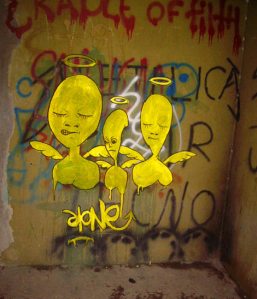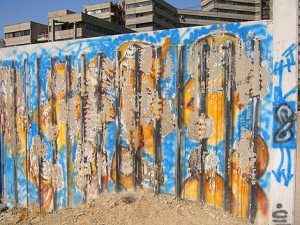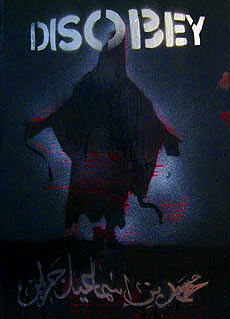Iran’s capital city, Tehran, has experienced a devastating amount of war and as a result, fear in recent history. Since the most recent uprising, triggered by the 2009 Irani presidential elections, a great deal of expressive Graffitti has begun to appear on rundown walls throughout the city.
One man, who goes by A1one (a.k.a Tanha), is responsible for the rise of expressive street art in Teheran. A1one began his career as a street painter indoors in the late 1990’s.
GOO: What does Your name A1one Stand for?
Alone : My Name has Many meanings and Story. The main is the reallity of being Alone those times i started graffiti in the Middlea East ‘s Most important capital – Tehran. Being the first like “A” in alphabet and “1” in numbers and another “one” in Writting form.another thing is
If you want to read Alone in Aranic You can read – Al-one (Alvan) whichmeans Colors. In Islam the Religion of most middleEast residents ,One is the God’s features. or Al one Means the Only One we all know him.
(An except from A1one’s interview with Goo. The full interview is posted A10ne’s Persian Graffiti facebook page.)
(Munch’s Scream “expresses the uncommon pressure inserted at the universities which was endured in silence.”)
When A1one first started his career as an artist his images were “not political”, according to the artist, but instead they were meant to be solely expressive—which one could argue is in turn political. His images were meant to spark silent conversation with and between other inhabitants of the tumultuous city.
His inspiration: “Passion to talk loud and hate to be silent when I need to shout.”
After his first spray painted work was completed on a freeway underpass, he received 3 calls from friends who recognized his work. Shortly after he formed a crew of artists who would join him in the expression of oppression through graffiti. The crew has developed since then and members have filtered in an out. Now the members of the A1one’s crew interact solely by email and other forms of social networking online—though the artist hopes to meet the members of his crew at some point, it is safer and easier to communicate via the internet.
Graffitti in Tehran, and all of Iran for that matter, is strictly prohibited. If caught in the act, an artist can be put to death immediately. Since the graffiti revolution of Tehran began in the early 2000’s laws condemning art have become harsher.For this reason, all works are created in the dead of night and public meetings with other artists do not take place.
His first work in the streets, “Searching for Friends” was done in the APC neighborhood—which is now covered in graffiti images.
(“Social Prison” done with fellow graffitist, Magoi)
(“Social Prison” Scratched out by an opposing party.)
“Mind Control” is written in Farsi on this image. It refers to the propaganda promoting a unity of islamic countries in universities and public spaces.
In the past 10 years, other artists tend to exhibit more openly politically charged messages seeping through their graffiti works than A1one’s often-subtle pieces. Since the 2009 elections, however, A1one’s art, like those of his crew and other crews, has entered the realm of protest art.
(Abu Ghraib prison – Mohammad Bin Ismaeel Jarayen)
(‘Bomb Children’ pasted on a bus stop in Keshavarz Blv., Tehran)
On the left it shows one of A1one’s Persian style graffitis meaning “PEACE” in Farsi (pronounced “Solh”), on the right it shows “A1one” in Farsi (pronounced “Tanha”).
A1one and his crew are far from the only groups of artists in the Middle East expressing themselves through graffiti. A small activist group that refers itself as The Green Ninjas were active during the election in 2009. They would litter the streets of Tehran with images that were in support of the Green Movement, those in support of reformist presidential candidate Mousavi.
In other parts of the Middle East, there are many more examples of protest graffiti. Beirut, in particular, is no stranger to the art. The political climate and laws regarding graffiti in Lebanon, however, are much more liberal than those of Iran. In Beirut one is subject to much more literal images. Phrases as well as images directly criticizing the government are found all over the city and the artists are not forced to create in the middle of the night. The different crews and individual artists are fairly well known. If caught in the act in Beirut, police will generally look away without giving the artist or his or her message a second thought. Protest graffiti like that of Beirut is also commonly found in the cities of Palestine, Jordan, and Cairo.
What to Make of Iranian and Arab Graffitti:
Is it a good thing? Is it a bad thing? Is it an incredibly stupid act?
I believe it is, especially in Iran, an incredibly brave act. It is truly something to be celebrated. It gives the artist a voice and the passersby a bit of assurance. Assurance that they are not alone and that something can be done. Protest graffiti, especially protest graffiti in the blood soaked streets of Tehran (and now in Tunis and Cairo) calls attention to political injustices and to social injustices and inspires people to begin to protest what is unjust or to keep fighting for what is right. I believe part of its success is that it is subtle. The protest art or Teheran, specifically, doesn’t just say “be here at this corner at this time and we will figh.” Instead, it is a symbol for the state of the political climate as well as a call to action.
Links to Middle Eastern Graffiti Sites:
http://irangraffiti.blogspot.com/
http://29letters.wordpress.com/2010/09/20/urban_arabic_graffiti/











